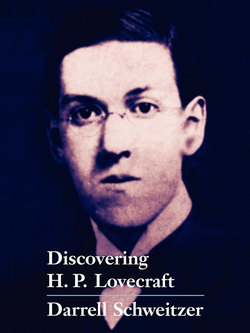Читать книгу Discovering H.P. Lovecraft - Darrell Schweitzer - Страница 5
На сайте Литреса книга снята с продажи.
ОглавлениеNOTES ON AN ENTITY, by Robert Bloch
It is difficult for me to comprehend that fifty years have passed since the death of Howard Phillips Lovecraft—and equally difficult for me to realize that I am now the youngest surviving member of what was once called “The Lovecraft Circle,” comprised of friends and correspondents of HPL.
I was for four years of my life one of these correspondents and, I trust, counted by him as a friend, although I never had the pleasure of meeting the man face to face. That expectation was reserved for the summer of 1937, at which time August Derleth hoped to have Lovecraft as his house-guest in Sauk City, Wisconsin. Since HPL’s longtime fellow-member of the amateur press organization, Maurice W. Moe, resided in Milwaukee, as did I, we both looked forward to a visit. But it was not to be: in March of that year, Lovecraft was dead.
As a fifteen-year-old fan, I’d entered into a continuing correspondence with the man I esteemed as the finest living writer of weird fiction. Within two years his encouragement and kindly critical advice had guided me to my own first sale, and at nineteen—the time of his death—I was solidly embarked on a permanent career as a writer.
My experience was not unique. Over the years many young fans and aspiring authors entered “The Lovecraft Circle” as appreciative readers, stayed on as charmed correspondents, and emerged as full-fledged fantasy fictioneers in their own right. And others, already appearing in print, found equal fascination in their contact with this remarkable intellect—and enriched their output thereby.
Like myself, they were profoundly influenced by the Lovecraft style, the Lovecraft concepts. The bulk of his out-put appeared in Weird Tales magazine, and during the dozen or so years during which his stories were printed there was no question as to who was the most popular writer for that period. His name was Seabury Quinn, and his stories about the “mercurial little detective, Jules de Grandin” almost invariably captured the cover-illustrations. But no one imitated, or was influenced by, the Seabury Quinn stories—and Lovecraft had a score of active acolytes in the fantasy field. Since his passing, the Lovecraft influence has spread; even today, in the works of younger writers the touch of HPLoquence is plainly discernible.
Let me put it less ponderously and more positively: no modern-day writer of fantasy and horror fiction has had more lasting influence on the field than H. P. Lovecraft.
Readers—and imitators—of Lovecraft’s friend and contemporary, Robert E. Howard, may dispute this; unfortunately, while Howard’s “sword-and-sorcery” sagas of Conan the Barbarian have been widely reprinted and widely copied, the fact remains that neither Howard’s style nor his subject-matter were uniquely his own creation. What he borrowed from others, his followers have since borrowed from him.
But Lovecraft, with his Cthulhu Mythos, was an innovator.
Earlier writers, Robert W. Chambers among them, had written stories in which they hinted or referred to a malign pantheon secretly scourging Earth. But the sketchy and oblique references meant nothing, except to the extent that they: prompted Lovecraft to invent and implement a full-fleshed mythology an cosmology of his own. He created a hideous, hidden history of mankind’s past—and of the earth and universe prior to the emergence of man from primordial slime. And in so doing, he enriched the imagination of all fantasy writers—his contemporaries and those who came after.
Most of these contemporaries, like myself, have since broken away from Lovecraft style and largely abandoned the subject-matter inherent in the Mythos. I haven’t written a “Lovecraftian” story, per se, in many years—though I suppose I could do so if I set myself to the task, as I once did whilst completing an unfinished tale by Edgar Allan Poe. (That “whilst,” by the way, is pure Lovecraft.) However, I most generally prefer to do my own thing; a course of action which HPL strongly advocated to all his writing acquaintances.
HPL’s work was not confined to the Cthulhu Mythos stories alone. He wrote science fiction, Dunsanian mood-pieces, and straight horror-stories. Each category had its own followers, amongst readers and writers alike; my own personal preference was for the out-and-out horror takes, or those in which the Mythos served merely as a background or explanatory device. “Pickman’s Model,” “The Shadow Over Innsmouth,” and “The Whisperer in Darkness” are possibly my all-time favorites, although I am fond of the totally-different “The Silver Key” because it seems to mirror the Lovecraft I knew from his letters.
And to those of us fortunate in such knowledge, or the greater gift of personal acquaintance, Lovecraft the writer was always secondary in our esteem. It was Lovecraft the man whom we most appreciated and admired.
I know I did. And today, half a century later, I still do.
The man who befriended a fifteen-year-old fan, who gave him a lifelong career, who set an example of fellowship and good-will, is the Lovecraft I choose to remember.
Some years before his passing, HPL penned a brief autobiographical sketch which, with characteristic modesty and good humor, he entitled, “Some Notes on a Nonentity.”
To me, Howard Phillips Lovecraft was an entity. A most important one. And I rejoice to see that his work—and his memory among readers and writers—endures.
